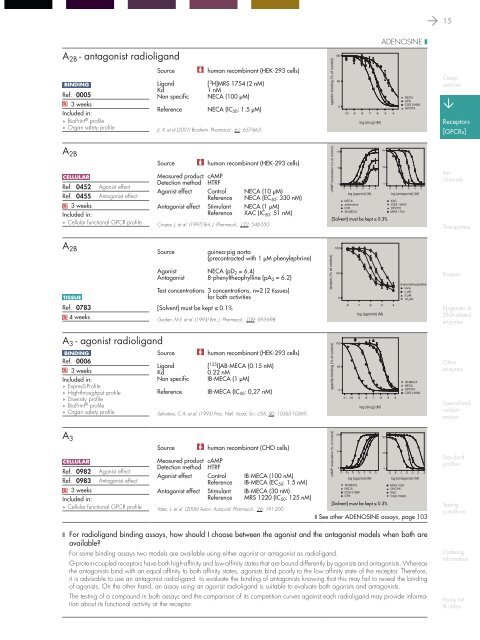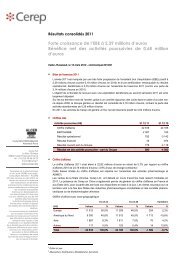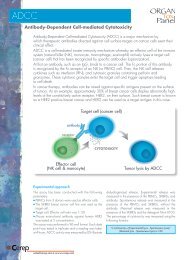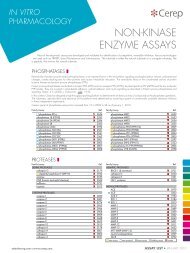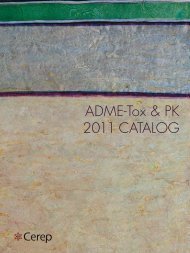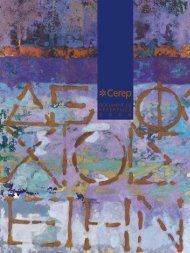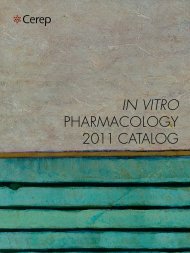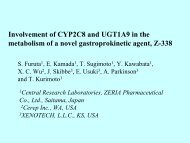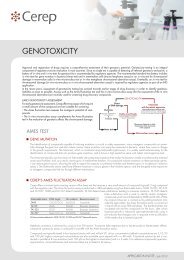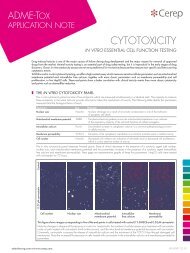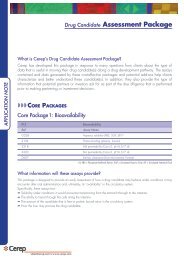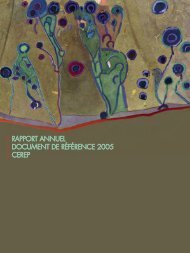in vitro PHARMACOLOGY 2011 CATALOG - Cerep
in vitro PHARMACOLOGY 2011 CATALOG - Cerep
in vitro PHARMACOLOGY 2011 CATALOG - Cerep
You also want an ePaper? Increase the reach of your titles
YUMPU automatically turns print PDFs into web optimized ePapers that Google loves.
15<br />
Adenos<strong>in</strong>e ❚<br />
A 2B - antagonist radioligand<br />
b<strong>in</strong>d<strong>in</strong>g<br />
Ref. 0005<br />
Q 3 weeks<br />
Included <strong>in</strong>:<br />
BioPr<strong>in</strong>t ® profile<br />
Organ safety profile<br />
Source<br />
Ligand<br />
Kd<br />
Non specific<br />
Reference<br />
human recomb<strong>in</strong>ant (HEK-293 cells)<br />
[ 3 H]MRS 1754 (2 nM)<br />
1 nM<br />
NECA (100 µM)<br />
NECA (IC 50 : 1.5 µM)<br />
Ji, X. et al.(2001) Biochem. Pharmacol., 61: 657-663.<br />
<br />
<br />
<br />
<br />
<br />
<br />
<br />
<br />
<br />
<br />
<strong>Cerep</strong><br />
services<br />
<br />
Receptors<br />
[GPCRs]<br />
A 2B<br />
cellul ar<br />
Ref. 0452<br />
Ref. 0455<br />
Q 3 weeks<br />
Included <strong>in</strong>:<br />
Agonist effect<br />
Antagonist effect<br />
Cellular functional GPCR profile<br />
Source<br />
human recomb<strong>in</strong>ant (HEK-293 cells)<br />
Measured product cAMP<br />
Detection method HTRF<br />
Agonist effect Control NECA (10 µM)<br />
Reference NECA (EC 50 : 330 nM)<br />
Antagonist effect Stimulant NECA (1 µM)<br />
Reference XAC (IC 50 : 51 nM)<br />
Cooper, J. et al. (1997) Brit. J. Pharmacol., 122: 546-550.<br />
cAMP modulation (% of control)<br />
100<br />
100<br />
50<br />
50<br />
0<br />
0<br />
-9 -8 -7 -6 -5 -4<br />
-9 -8 -7 -6 -5 -4<br />
log [agonist] (M)<br />
log [antagonist] (M)<br />
NECA<br />
XAC<br />
adenos<strong>in</strong>e<br />
CGS 15943<br />
CPA<br />
DPCPX<br />
IB-MECA<br />
MRS 1754<br />
[Solvent] must be kept ≤ 0.3%<br />
Ion<br />
channels<br />
Transporters<br />
A 2B<br />
tissue<br />
Source<br />
gu<strong>in</strong>ea-pig aorta<br />
(precontracted with 1 µM phenylephr<strong>in</strong>e)<br />
Agonist NECA (pD 2 = 6.4)<br />
Antagonist 8-phenyltheophyll<strong>in</strong>e (pA 2 = 6.2)<br />
Test concentrations 3 concentrations, n=2 (2 tissues)<br />
for both activities<br />
tension (% of control)<br />
100<br />
50<br />
0<br />
8-phenyltheophyll<strong>in</strong>e<br />
none<br />
1 µM<br />
3 µM<br />
10 µM<br />
K<strong>in</strong>ases<br />
Ref. 0783<br />
Q 4 weeks<br />
[Solvent] must be kept ≤ 0.1%<br />
Gurden, M.F. et al. (1993) Brit. J. Pharmacol., 109: 693-698.<br />
-8 -7 -6 -5 -4<br />
log [agonist] (M)<br />
Epigenetic &<br />
DNA-related<br />
enzymes<br />
A 3 - agonist radioligand<br />
b<strong>in</strong>d<strong>in</strong>g<br />
Ref. 0006<br />
Q 3 weeks<br />
Included <strong>in</strong>:<br />
ExpresS Profile<br />
High-throughput profile<br />
Diversity profile<br />
BioPr<strong>in</strong>t ® profile<br />
Organ safety profile<br />
Source<br />
Ligand<br />
Kd<br />
Non specific<br />
Reference<br />
human recomb<strong>in</strong>ant (HEK-293 cells)<br />
[ 125 I]AB-MECA (0.15 nM)<br />
0.22 nM<br />
IB-MECA (1 µM)<br />
IB-MECA (IC 50 : 0,27 nM)<br />
Salvatore, C.A. et al. (1993) Proc. Natl. Acad. Sci. USA, 90: 10365-10369.<br />
<br />
<br />
<br />
<br />
<br />
<br />
<br />
<br />
<br />
<br />
Other<br />
enzymes<br />
Specialized<br />
cellular<br />
assays<br />
A 3<br />
cellul ar<br />
Ref. 0982<br />
Ref. 0983<br />
Q 3 weeks<br />
Included <strong>in</strong>:<br />
Agonist effect<br />
Antagonist effect<br />
Cellular functional GPCR profile<br />
Source<br />
human recomb<strong>in</strong>ant (CHO cells)<br />
Measured product cAMP<br />
Detection method HTRF<br />
Agonist effect Control IB-MECA (100 nM)<br />
Reference IB-MECA (EC 50 : 1.5 nM)<br />
Antagonist effect Stimulant IB-MECA (30 nM)<br />
Reference MRS 1220 (IC 50 : 125 nM)<br />
Yates, L. et al. (2006) Auton. Autacoid. Pharmacol., 26: 191-200.<br />
<br />
<br />
<br />
<br />
<br />
<br />
<br />
<br />
<br />
[Solvent] must be kept 0.3%<br />
<br />
<br />
<br />
<br />
<br />
<br />
<br />
<br />
<br />
<br />
<br />
<br />
<br />
<br />
<br />
❚ See other Adenos<strong>in</strong>e assays, page 103<br />
Standard<br />
profiles<br />
Test<strong>in</strong>g<br />
conditions<br />
<br />
❚ For radioligand b<strong>in</strong>d<strong>in</strong>g assays, how should I choose between the agonist and the antagonist models when both are<br />
available?<br />
<br />
For some b<strong>in</strong>d<strong>in</strong>g assays two models are available us<strong>in</strong>g either agonist or antagonist as radioligand. <br />
<br />
<br />
G-prote<strong>in</strong>-coupled receptors have both high-aff<strong>in</strong>ity and low-aff<strong>in</strong>ity states that are bound differently by agonists and antagonists. Whereas<br />
the antagonists b<strong>in</strong>d with an equal aff<strong>in</strong>ity to both aff<strong>in</strong>ity states, agonists b<strong>in</strong>d poorly to the low aff<strong>in</strong>ity state of the receptor. Therefore,<br />
it is advisable to use an antagonist radioligand to evaluate the b<strong>in</strong>d<strong>in</strong>g of antagonists know<strong>in</strong>g that this may fail to reveal the b<strong>in</strong>d<strong>in</strong>g<br />
of agonists. On the other hand, an assay us<strong>in</strong>g an agonist radioligand is suitable to evaluate both agonists and antagonists.<br />
The test<strong>in</strong>g of a compound <strong>in</strong> both assays and the comparison of its competition curves aga<strong>in</strong>st each radioligand may provide <strong>in</strong>formation<br />
about its functional activity at the receptor.<br />
Order<strong>in</strong>g<br />
<strong>in</strong>formation<br />
Assay list<br />
& <strong>in</strong>dex


